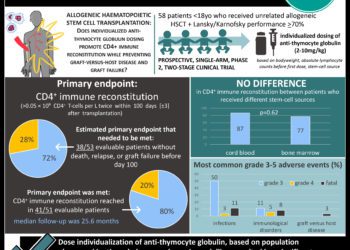Improvements in survival after allogeneic hematopoietic cell transplantation have continued over the past decade
1. In this retrospective study comparing patients who received first allografts in 2003-2007 versus 2013-2017, significant reductions in mortality were observed in the more recent cohort, largely due to a decline in the rate of nonrelapse mortality.
2. Liver, kidney, and lung complications occurred far less frequently in the more recent cohort.
Evidence Rating Level: 2 (Good)
Study Rundown: In the decades following the advent of allogeneic hematopoietic cell transplantation, morbidity and mortality have fallen significantly thanks to improvements in supportive care, infection prevention and management, and conditioning protocols. Despite these advances, donor selection and graft-versus-host disease (GVHD) remain significant challenges. This study aimed to evaluate the overall trajectory of improved outcomes in recent years, analyzing a number of variables including day-200 nonrelapse mortality (NRM), relapse-related mortality, GVHD frequency and severity, and infectious complications. Findings showed that, rather than reaching a survival plateau, the historical trend has continued with a 34% reduction in overall mortality from the early 2000s mostly due to reduced day-200 NRM from organ damage, infections, and GVHD. It is hypothesized that these changes were caused by many incremental advances in aspects such as conditioning therapy, GVHD prophylaxis, prednisone dosing, and infection control. Despite this encouraging result, the frequency of overall mortality remains high, highlighting the need to address persistent impediments such as posttransplant relapse and cancer progression. This study was limited by the difficulty of incorporating all relevant factors into analysis. For instance, modern molecular and genomic testing was not available a decade ago, potentially affecting the magnitude of detected differences.
Click here to read the study in Annals of Internal Medicine
Relevant Reading: Epidemiology and biology of relapse after stem cell transplantation
In-Depth [retrospective cohort]: In this study, data from all persons who received a first allograft from 2003-2007 and from 2013-2017 were drawn from 5 sources including hospital and specialty databases. To account for comorbidities prior to transplant, all patients were assigned a score based on the augmented Hematopoietic Cell Transplantation Comorbidity Index (HCT-CI). Hepatic, renal, and pulmonary injuries were assessed via relevant biomarkers and use of specific therapies (i.e. renal replacement, mechanical ventilation). Other variables including viral/bacterial/fungal infection, acute graft-versus-host disease (GVHD), and prednisone exposure were also assessed. The more recent cohort was marked by older patients, more patients with high HCT-CI scores, and the use of less intensive conditioning. Day-200 nonrelapse mortality occurred in 16% and 11% of the earlier and later cohorts, respectively (adjusted hazard ratio (HR), 0.66; 95% confidence interval (CI), 0.48-0.89). Significant decreases in frequency were also observed for relapse or progression (adjusted HR, 0.76; 95% CI, 0.61-0.94), relapse-related mortality (adjusted HR, 0.69; 95% CI, 0.54-0.87), and overall mortality (adjusted HR, 0.66; 95% CI, 0.56-0.78, p<0.001). Liver dysfunction, acute kidney injury, respiratory failure, and acute GVHD of peak grade 3 or 4 all occurred less frequently in the 2013-2017 cohort.
Image: PD
©2020 2 Minute Medicine, Inc. All rights reserved. No works may be reproduced without expressed written consent from 2 Minute Medicine, Inc. Inquire about licensing here. No article should be construed as medical advice and is not intended as such by the authors or by 2 Minute Medicine, Inc.







